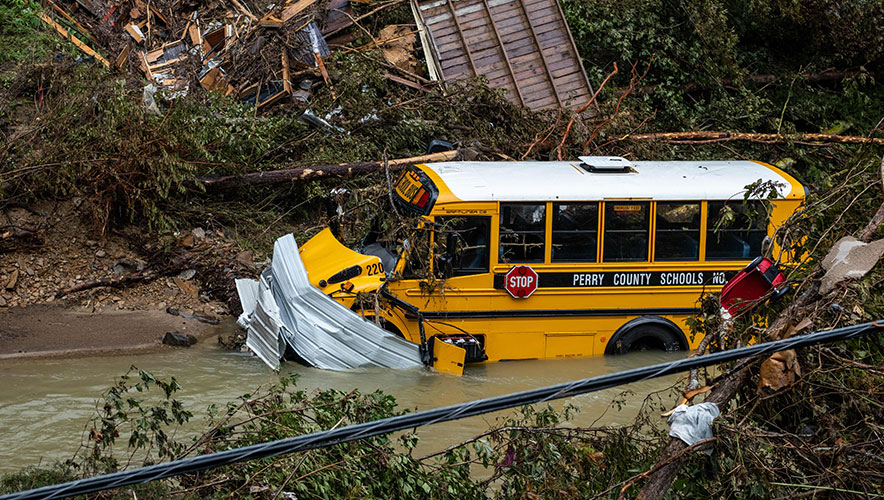Concentrated Rainfall Floods U.S. Midwest
Summer storms are nothing new for the U.S. Midwest. But this year, wave after wave of heavy rainstorms have swamped whole regions, causing widespread damage and triggering rescue operations.
On 25-26 July, Missouri received a record 9 inches of rain within 24 hours—the most rain ever recorded for the state. A series of “training” thunderstorms—storms the generate tremendous rainfall on top of relatively small areas resulting in flash flooding—rolled through the region one after the other, producing 25 percent of the city’s annual rainfall in a mere 12 hours.
The subsequent flooding caused extensive damage to residences and businesses, before a second round of storms a few days later led to a second wave of flash flooding. One section of St. Louis was submerged under 7 feet of water, trapping residents in their homes, CNN reported. Portions of Interstate 70—a major highway that runs through the St. Louis area—were covered with more than a foot of water, as well as a variety of disabled vehicles.
Record-breaking rainfall brought devastating flash floods and landslides to Missouri, Kentucky, and other parts of the central United States in late July 2022. Scientists have found extreme weather events are becoming more likely with climate change. https://t.co/HkNCB9q5qd pic.twitter.com/RZZrw3faLc
— NASA Earth (@NASAEarth) August 3, 2022
On 28 July, catastrophic flash flooding hit parts of eastern Kentucky, causing mudslides and killing at least 37 people, according to the NASA Earth Observatory. Many more people were trapped in homes and businesses, and thousands were sent to shelters, the Lexington Herald-Leader reported. Between 8 and 10 inches of rain fell within 48 hours, followed by an extra 4 inches on 31 July. Flooding on the North Fork of the Kentucky River surged to a new record, rising 12 feet in 12 hours.
As rain continued to fall, emergency services faced severe challenges reaching people in need of help. Roads were blocked by trees, washed away, or covered with water. The heavy rains also knocked out power to more than 24,000 people. Shortly after the storms, a heatwave kicked temperatures up above 80 to 90 degrees Fahrenheit with heavy humidity, USA Today said.
'They have a car, a sharp black Dodge Challenger. The problem is they don’t have a bridge to drive it across.'
— Ryan C. Hermens (@ryanhermens) August 3, 2022
.@billestep1 writes about the scores of small bridges damaged in record Eastern Kentucky flooding: https://t.co/axPjIy4pw4 via @heraldleader pic.twitter.com/6XWbduUxVd
“Some communities are still recovering from massive floods in January and February,” the Herald-Leader reported. “Flooding has become more frequent and more destructive, thanks to more severe weather caused by climate change, and the valleys and steep hills of Eastern Kentucky that make it more conducive to flash flooding. In March and February 2020, widespread flooding was recorded in 31 Kentucky counties, from Fayette to Martin. The state tallied more than $72 million in damage.”
In another deluge, regions of south and central Illinois were hit by more than 10 inches of rain. Water inundated roads and intersections, and news sources in Decatur, Illinois, reported cars submerged in high water. A stalled front kept the storm cell over the region for a long period of time, dropping more and more precipitation on a concentrated area, The Washington Post reported.
“Monday night’s event fits into a pattern of ultrarare high-end rain events that have struck the United States in the past week,” according to the Post. “What happened in St. Louis and Kentucky both fall under the umbrella of 1,000-year rain events, meaning the amount of rain that fell during such a short window would have only a 0.1 percent chance of happening any year.”
The report continued: “Human-caused climate change is likely playing a role in amplifying the severity and frequency of heavy rainfall events. For every degree Fahrenheit the air temperature increases, the atmosphere can hold about 4 percent more water. That disproportionately tilts the scales toward more exceptional events, and episodes like which have occurred in the past seven days will become more routine.”
As flooding risks become more prevalent, resilience will need to take on new importance for organizations. Security and business leaders who factor resilience into all decisions—from where to build a new property to adding redundancies to cover staff unavailability during disasters—will drive better choices in a climate unstable world, said Michael Szönyi, Flood Resilience Program Lead at Zurich Insurance Company, in an interview with Security Management in 2021.
The resiliency concept has four Rs that combined drive creative problem-solving amid crisis, Szönyi said: robustness, redundancy, resourcefulness, and rapidity. An organization could invest in robust engineering to keep a risk at bay; multiple facilities or personnel cross-training could produce resiliency; creative problem-solvers bring resourcefulness to the table; and preparedness and planning can help boost rapid responses. But no one element can protect an organization in full.
“Resilience is a multifaceted concept,” he said. “Resilience means tapping into different kinds of resources and trying to solve the problem from a different angle. That’s how we try to portray this resilience concept. It’s almost like a Rubik’s cube. You have a lot of different colored surfaces, and depending on how you turn your resilience box, you see a new perspective. You see new options.”
